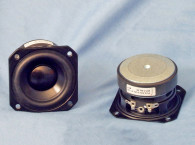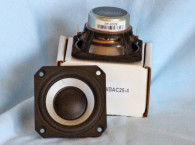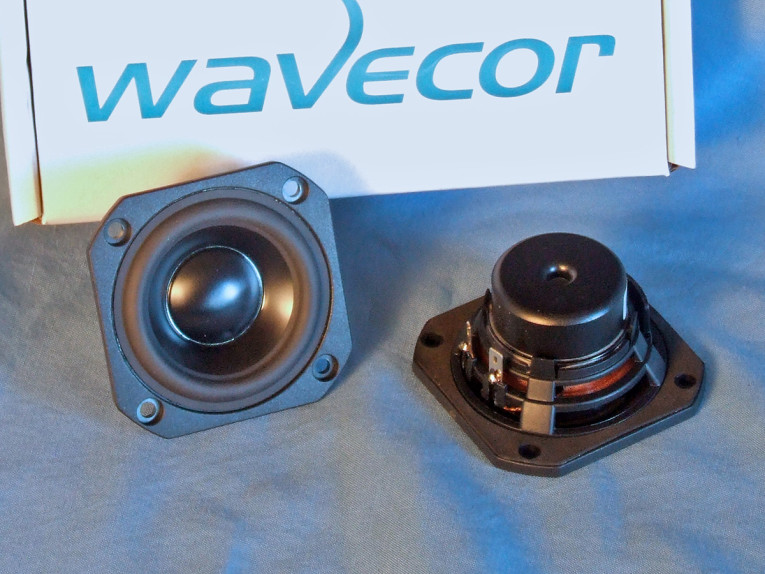

The FR070WA05 is a new 2.75” aluminum cone full-range driver from Wavecor (Photo 1). This driver is built on a proprietary injection-molded polymer four-spoke frame. Like most contemporary drivers, the area below the spider mounting shelf is totally open for increased cooling. The cone assembly consists of a black anodized aluminum cone, with a 27mm diameter black anodized aluminum dust cap (directly coupled to the 26mm vented black non-conducting black fiberglass voice coil former), and suspended with a low loss (high Qm) NBR surround and a 45mm diameter flat Conex spider (damper).
Powering the cone assembly is a dual neodymium motor with a copper cap shorting ring (Faraday shield) and a milled return cup with black emissive coating and 6mm diameter flared vent. Tinsel leads connect on one side of the cone to a pair of solderable gold-plated terminals.
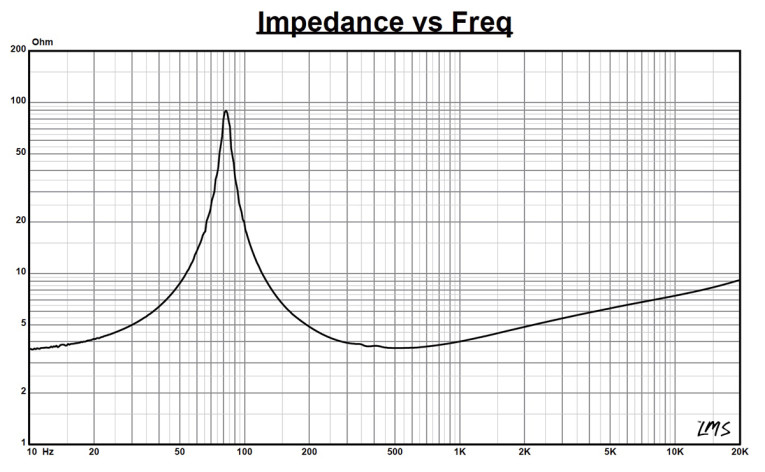
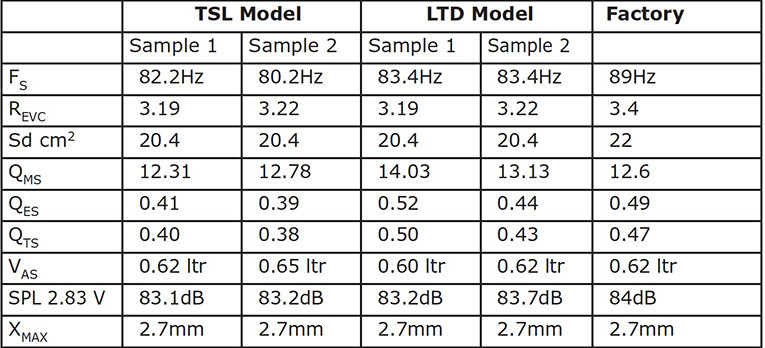


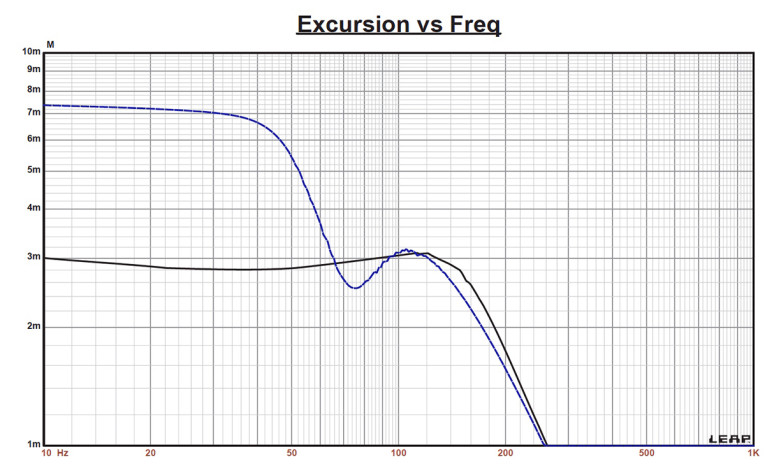
I began testing the FR070WA05 using the LinearX LMS analyzer and the Physical Lab IMP Box, which is shown in Photo 2 and was provided to Voice Coil courtesy of Physical Lab. Please note that the Physical Lab IMP Box measures current and voltage measurements exactly the same as the LinearX VIBox, however, the LinearX VIBox is no longer available. This was used to create both voltage and admittance (current) curves with the driver clamped to a rigid test fixture in free-air at 0.3V, 1V, 3V, and 6V, with the 6V curves remaining linear enough for LEAP 5 to get a good curve fit, impressive for this small a diameter driver.
As has become the protocol for Test Bench testing, I no longer use a single added mass measurement and instead used actual measured mass—the manufacturer’s measured Mmd data (3.54 grams). Next, I post-processed the eight 550-point stepped sine wave sweeps for each of the FR070WA05 samples and divided the voltage curves by the current curves (admittance) to produce the impedance curves, phase-generated by the LMS calculation method. I imported the data, along with the accompanying voltage curves, to the LEAP 5 Enclosure Shop software.
Since most Thiele-Small (T-S) data provided by OEM manufacturers is being produced using either a standard driver model or the LEAP 4 TSL model, I additionally created a LEAP 4 TSL model using the 1V free-air curves. I selected the complete data set, the multiple voltage impedance curves for the LTD model, and the 1V impedance curve for the TSL model in the transducer derivation menu in LEAP 5 and created the parameters for the computer box simulations.
Figure 1 shows the 1V free-air impedance curve. Table 1 compares the LEAP 5 LTD and TSL data and factory parameters for both of the FR070WA05 samples. The FR070WA05’s LEAP TSL/LTD parameter calculation results were reasonably close to the factory data, given the factory data used a less conservative Sd number.
Following my usual protocol, I configured computer enclosure simulations using the LEAP LTD parameters for Sample 1. This consisted of an 18 in3 Butterworth-sealed box with 25% damping material (fiberglass), and a 28.7 1in3 Chebychev / Butterworth vented enclosure tuned to 72Hz with 15% damping material in the box.
Figure 2 displays the results for the FR070WA05 driver in the sealed and vented box simulations at 2.83V and at a voltage level sufficiently high enough to increase cone excursion to Xmax + 15% (3.1mm for the FR070WA05). This produced a F3 frequency of 128Hz (F6 = 98Hz) with a Qtc = 0.67 for the 18 in3 Butterworth sealed enclosure and –3dB = 89Hz (F6 = 73Hz for the 28.7 in3 Chebychev / Butterworth vented simulation.
Increasing the voltage input to the simulations until the maximum linear cone excursion was reached resulted in 95dB at 11V for the sealed Butterworth enclosure simulation and 97dB for the same 11V input level for the Chebychev/Butterworth vented enclosure Figure 3 shows the 2.83V group delay curves. Figure 4 shows the 11V excursion curves. As usual, a steep high-pass filter on the vented enclosure would prevent over excursion at higher voltage levels.
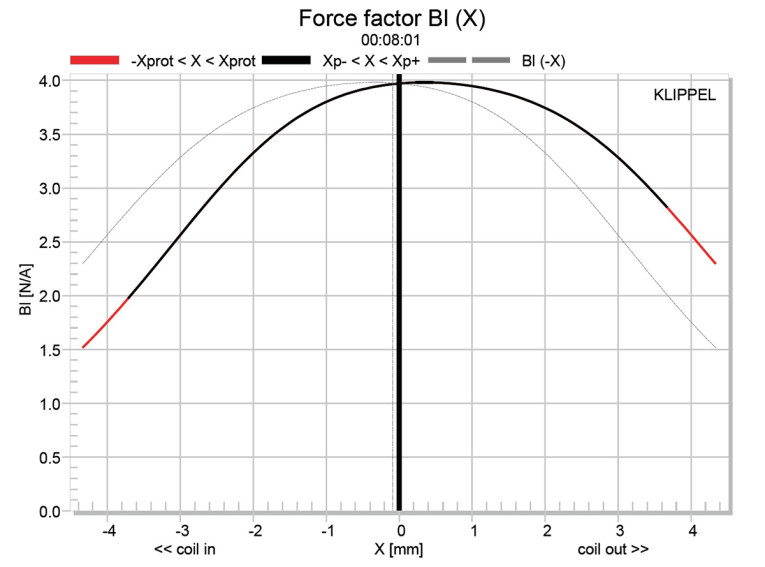

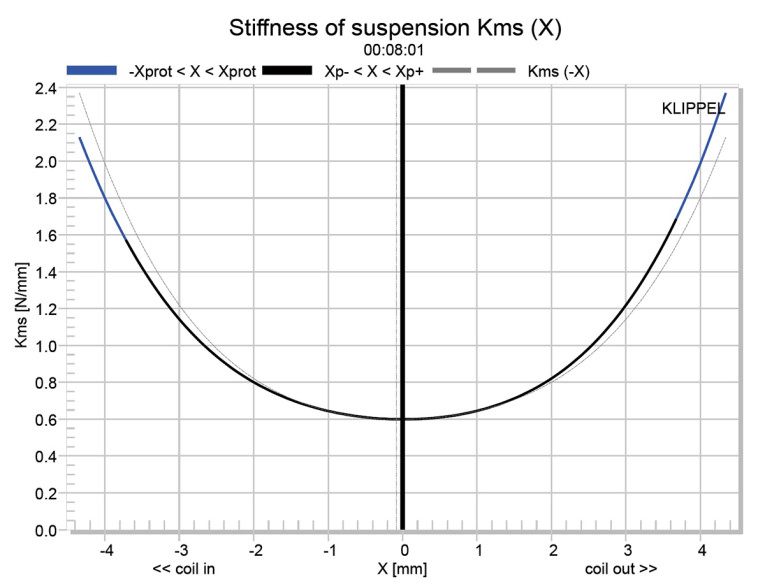

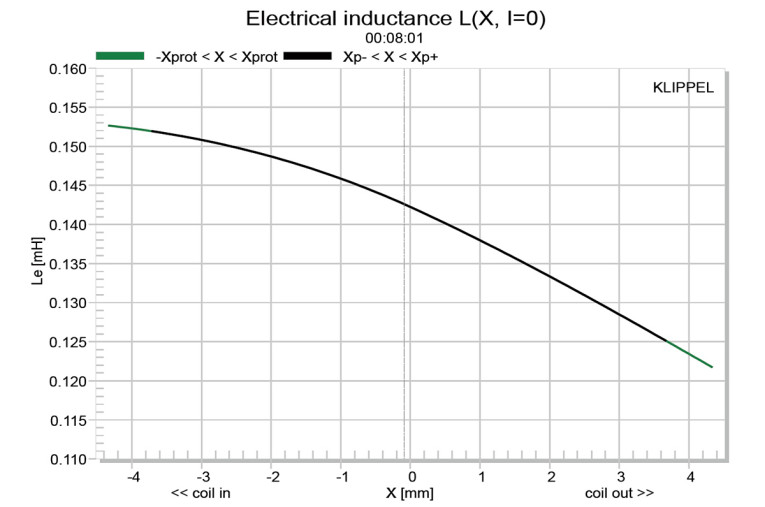
Klippel analysis for the FR070WA05 driver produced the Bl(X), Kms(X) and Bl and Kms symmetry range plots given in Figures 5-8. (Our analyzer is provided courtesy of Klippel GmbH, and testing was performed by Pat Turnmire, owner of Redrock Acoustics and author of the SpeaD and RevSpeaD transducer design software.) The Bl(X) curve for the FR070WA05 (Figure 5) is relatively broad and symmetrical with fairly minor amount of offset to the curve, but not bad for a short Xmax 2.75” diameter driver. Looking at the Bl symmetry plot (Figure 6), this curve shows a minor coil-out (forward) offset that increases to a maximum 0.49mm at the driver’s physical 2.7mm Xmax.
Figure 7 and Figure 8 show the Kms(X) and Kms symmetry range curves for the FR070WA05 driver. The Kms(X) curve (Figure 7) is also rather symmetrical, with almost zero offset. Looking at the Kms symmetry range curve (Figure 8), there is about 0.07mm forward offset at the physical Xmax position, which is negligible.
Displacement limiting numbers calculated by the Klippel analyzer for the FR070WA05 driver were XBl @ 82% Bl is 2.1mm and for XC @ 75% Cms minimum was 1.9mm, which means that for this woofer, compliance is the most limiting factor for prescribed distortion level of 10%.
Using the more conservative XBl @ 70% and XC @ 50%, the criteria for 20% distortion level, XBl = 2.7 and XC = 3.0, both close to the driver’s physical Xmax. Given the small excursion difference between the two distortion criteria, this is decent performance for a 2.75” diameter driver.
Figure 9 gives the FR070WA05’s inductance curve Le(X). Inductance will typically increase in the rear direction from the zero rest position as the voice coil covers more pole area, which is what happens. However, this device has a copper shorting ring, so the inductance variation is only 0.012mH to 0.008mH from the in and out Xmax positions, which is very good.
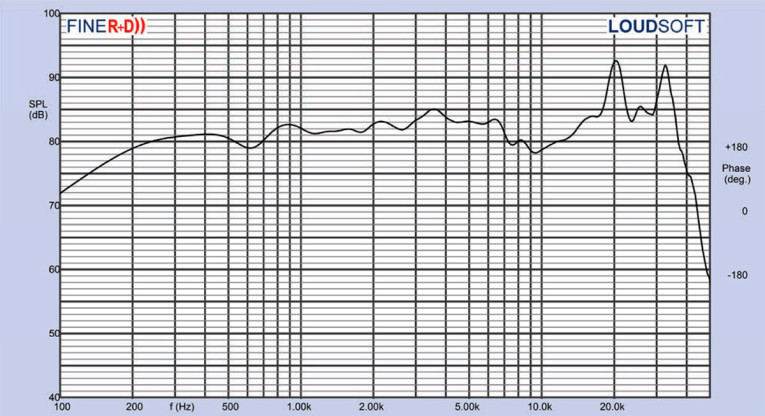
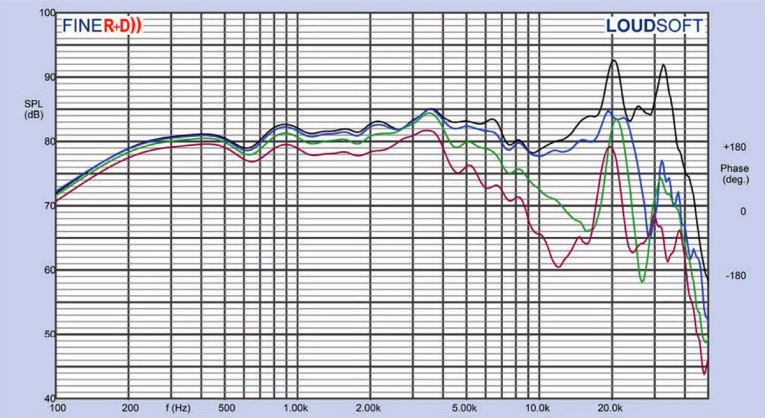
purple dash dot = 45°).
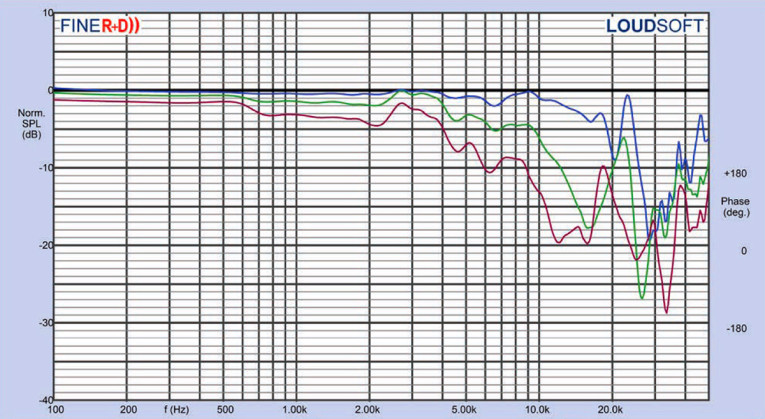
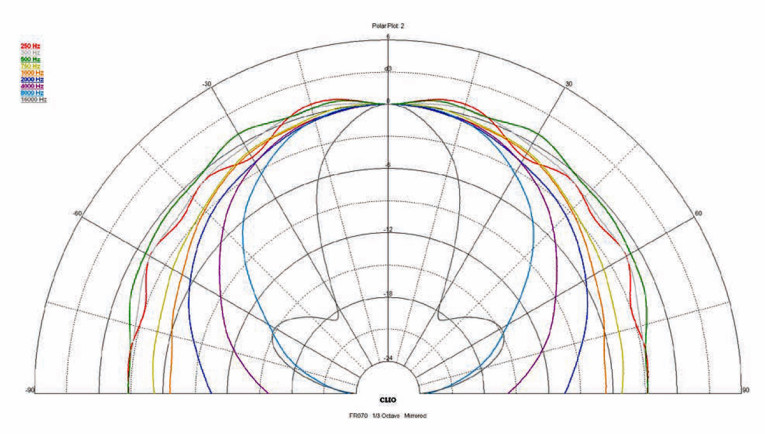
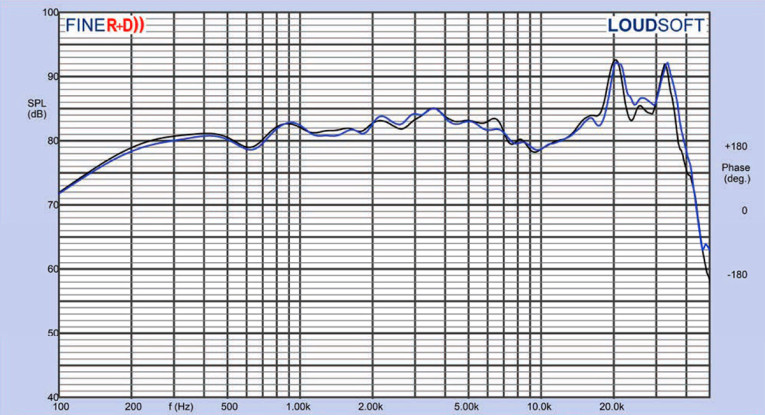
Next, I mounted the FR070WA05 in an enclosure that had a 9” × 4” baffle and was filled with damping material (foam). I measured the transducer on- and off-axis from 300Hz to 40kHz frequency response using the LoudSoft FINE R+D analyzer (courtesy of LoudSoft) and the GRAS 46BE microphone (courtesy GRAS Sound & Vibration) both on- and off-axis from at 2V/0.5m normalized to 2.83V/1m using the cosine windowed FFT method. All of these SPL measurements also included a 1/6 octave smoothing, which approximate the 100-point frequency response resolution I used with LMS for a number of years.
Figure 10 shows the FR070WA05’s on-axis frequency response which is ±3.5dB from 300 Hz to 18 kHz. The response extends out to about 35kHz, with the primary aluminum break-up modes at 20kHz and 32kHz. Figure 11 displays the on- and off-axis frequency response at 0°, 15°, 30°, and 45°. Figure 12 gives the Figure 11 off-axis curves normalized to the on-axis response. Figure 13 shows the CLIO 180° polar plot (measured in 10° increments). Figure 14 provides the two-sample SPL comparison, indicating the two samples were closely matched within less than 1.25dB out to 20kHz.
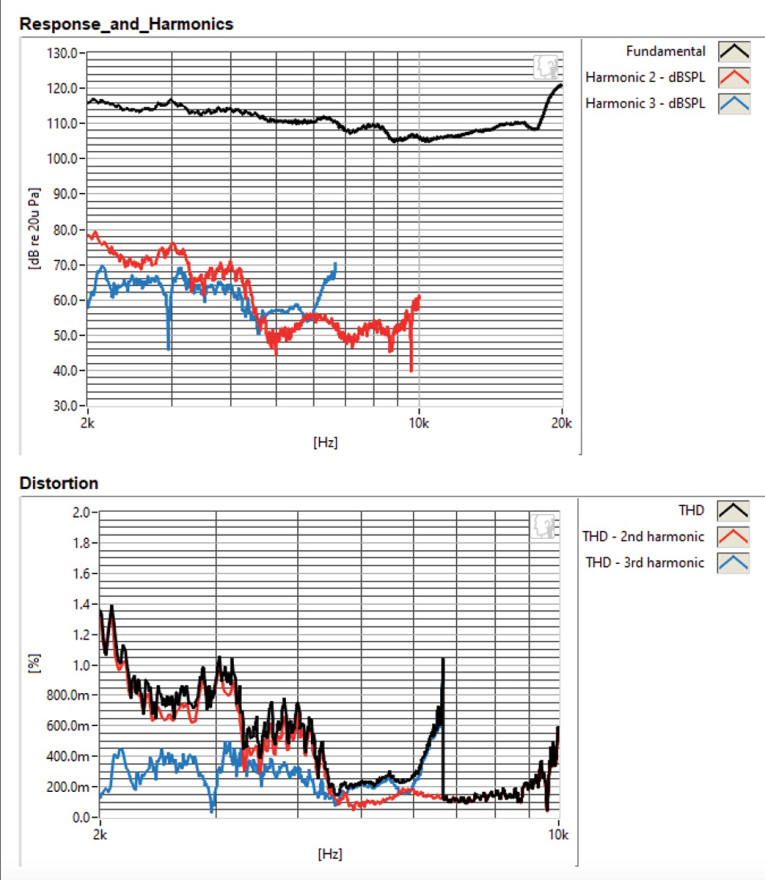

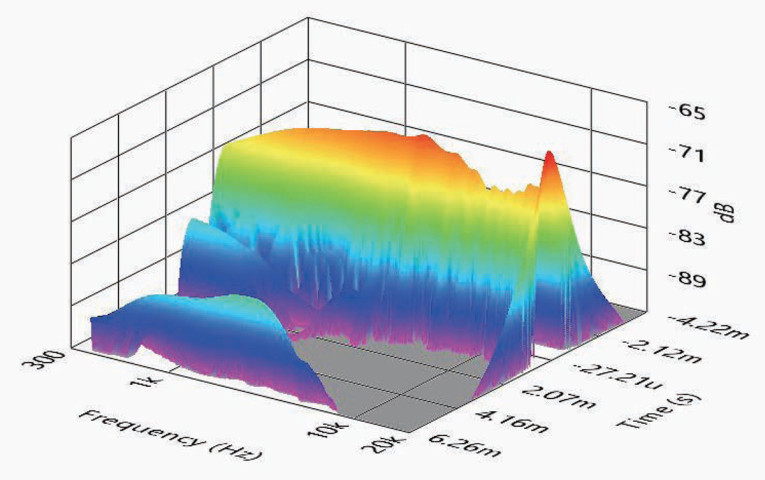
Finally, I employed the Listen SoundCheck V18 software, and the AudioConnect analyzer with the Listen 1/4” SCM microphone and the power supply (courtesy of Listen, Inc.) to measure distortion and generate time-frequency plots. For the distortion measurement, I mounted the FR070WA05 driver rigidly in free-air and set the SPL to 90dB at 1m (7.66V) using a noise stimulus. Then, I measured the distortion with the microphone placed 10cm from the dust cap. This produced the distortion curves shown in Figure 15.
I then used SoundCheck to get a 2.83V/1m impulse response for this driver and imported the data into Listen’s SoundMap Time/Frequency software. Figure 16 shows the resulting cumulative spectral decay (CSD) waterfall plot. Figure 17 shows the Wigner-Ville plot (chosen for its better low-frequency performance).
Looking over all the above data, Wavecor’s FR070WA05 should find applications in any number of projects from Bluetooth speakers to computer monitors. For more information, visit www.wavecor.com. VC
This article was originally published in Voice Coil, February 2021.




